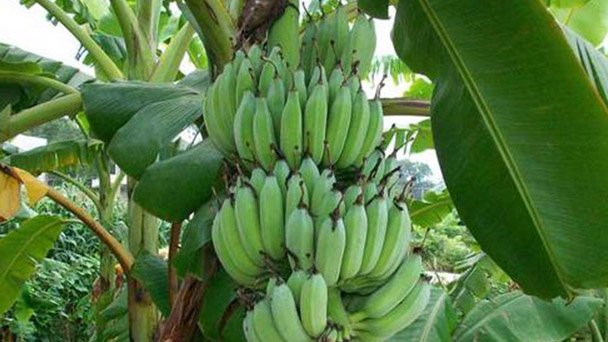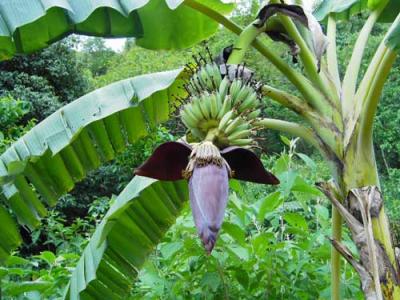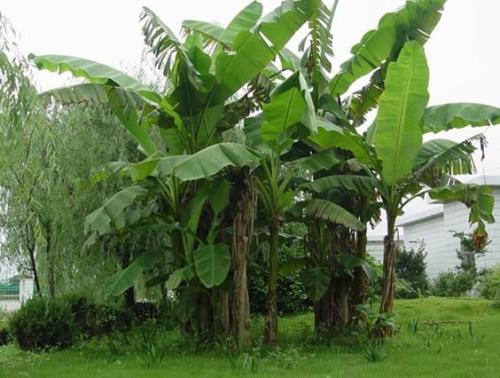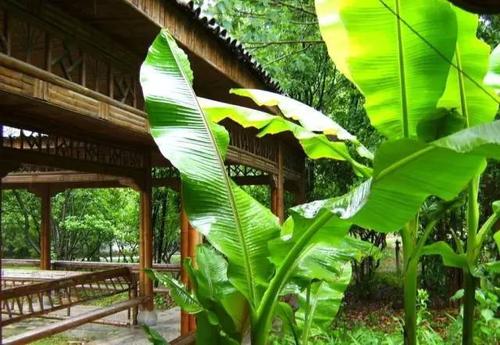Musa basjoo Siebold (Japanese Banana) profile
Written by Maggie
Nov 03 2021

Musa basjoo Siebold (Japanese Banana) is a common ornamental plant in China. The leaves of Musa basjoo Siebold are hypertrophic and green, which is suitable for planting in small courtyards or on the Bank of rockeries. It is not suitable for row planting. Musa Basjoo Siebold can be eaten. Musa Basjoo Siebold and banana have the same nutritional value. From the perspective of Traditional Chinese medicine, both of them have the effect of moistening intestines and relieving constipation, but the banana is cool.
Musa Basjoo Siebold picture

Musa Basjoo Siebold morphological characteristics
The Musa Basjoo Siebold plant is 2.5-4 meters tall. Leaf is blade oblong, 2-3 m long, 25-30 cm wide, apex obtuse, base rounded or asymmetrical, glossy green. The petiole is stout, 30 cm long. Inflorescences are terminal, pendulous. Bracts are reddish brown or purple. Male flowers are in the upper part of inflorescence, female flowers in the lower part of inflorescence. Female flowers are 10-16 in each bract, arranged in 2 rows. Connate sepals 4-4.5 cm in length, with 5 (3 2) teeth cleft, free tepals nearly as long as connate tepals, with a small cusp at the tip. Berries are three-ribbed, oblong, 5-7 cm long, 3-5-ribbed, subsessile, fleshy, with many seeds. Seeds are black, verrucous and irregular angular, 6-8 mm wide.
Musa Basjoo Siebold growth habit
Musa Basjoo Siebold is a perennial herbaceous plant with large, wide leaves, warm and cold tolerance, strong meristem resistance, half-shade tolerance, strong adaptability and fast growth.
High mountains and dense forests, fertile land is very suitable for planting musa basjoo Siebold. musa basjoo siebold is most appropriate to grow in loose, fertile, breathable soil. Proper shading is beneficial to plant growth and quality improvement.
The Musa Basjoo Siebold is not hardy and must be kept above 4 ° C in winter, but can also withstand low temperatures of 0 ° C for a short time. The Musa Basjoo Siebold is Tolerant of half - shade, too shade plant growth is poor, difficult to flower. Because its leaf is parallel vein, the structure is loose, and can be blown easily by strong wind crack, we should choose the place that takes shelter from wind to plant. The Musa Basjoo Siebold prefers wetting, we should often water and spray water to the plant in order to maintain high soil and air humidity, but avoid continuous water in the soil, otherwise easy to rot roots.

The Musa Basjoo Siebold distribution area
Musa Basjoo Siebold is found mostly in subtropical regions and is distributed in Japan, Taiwan and Mainland China including Shanghai, Hunan, Zhejiang, Hubei, Guizhou, Yunnan, Shaanxi, Sichuan, Jiangsu, Guangxi and other places. It grows at an altitude of 500 m to 800 m. It is often found in river valleys, villages and hillsides.
Musa Basjoo Siebold propagation method
Musa Basjoo Siebold usually propagates by individual plants, preferably in early April. To separate the plants, dig the soil around the Musa Basjoo Siebold with a spade or hoe and expose the small Musa Basjoo Siebold head and the stolon roots. The small Musa Basjoo Siebold head and the stolon roots are then cut off with a sharp knife. If the stolon of a plant has fibrous roots, the Musa Basjoo Siebold can be planted directly in a yard or used as a potting plant. If the cut seedlings do not have fibrous roots, you may first fill them with plain sandy soil and bury them in the sandy seedbed. To consider the need for potting in the future, short stolons may be cut appropriately to facilitate potting in the future. Care must be taken not to injure the nodule during operation. Unrooted seedlings should be cultivated with 3 ~ 4 cm spacing. During cultivation, the small Musa Basjoo Siebold head should be completely buried in sand and watered thoroughly. The soil should be kept moist frequently and the temperature should be controlled between 10 ~ 25℃.

Musa Basjoo Siebold's main value
1. Edible value: Musa Basjoo Siebold has a large and thin skin, tender and smooth meat, sweet and refreshing, appetizing, and helping digestion.
2. Medicinal value: Musa Basjoo Siebold flesh indication: Musa Basjoo Siebold root functions: heat-clearing, thirst-quenching, diuresis, detoxification. It can treat febrile diseases, irritability, thirst, jaundice, edema, beriberi, blood poisoning, Carbondale, malignant boils, antipyretic. Musa Basjoo Siebold leaf functions: heat-clearing, diuresis and detoxification, fever, heatstroke, beriberi, carbuncle swelling, heat, and burns. Musa Basjoo Siebold flower functions: reducing phlegm and firmness, smoothing liver, and stasis, and passing through the meridian, chest fullness, abdominal distension, acid swallowing, nausea, vomiting, phlegm, dizziness, palpitation, women's palpitation.
3. Musa basjoo Siebold is an important plant resource in tropical and subtropical areas. Musa basjoo Siebold's pseudostem fiber can be used to make seawater resistant ropes and cables. Cultivated banana (or plantain) is one of the famous fruits in tropical and subtropical areas. It can also be used as a substitute for grain. It is mainly made into dried banana (or banana powder) for food. Musa basjoo Siebold dry or Musa basjoo Siebold powder is rich in nutrition (according to rough analysis: starch 74%, protein 3.7-4.2%, fat 0.51%, moisture 1.2-1.9%), in which the protein content is quite high. Musa basjoo Siebold starch is particularly easy to digest and rich in vitamins A, B and C. It is completely suitable for human staple food. At the same time, Musa basjoo Siebold, as a crop, has many advantages: high yield (the average yield per mu is 5000 kg, the net meat weight after peeling is 3000 kg, and 1000 kg of starch can be obtained). It can be harvested continuously for 4-8 years, save labor, harvest all year round, equal busy and leisure, easy processing, can be planted in mountainous areas, does not occupy paddy fields, has few diseases and pests, and has little impact of water and drought.
From the perspective of comprehensive utilization, Musa basjoo Siebold peel can be fed to pigs, male flowers can be used as vegetables, and Musa basjoo Siebold can not only feed pigs and make wine, but also make flour; Pseudostem fiber can be used as hemp and weaving (called plantain Pueraria), ash can also be burned to make alkali, and leaves can be wrapped or wax powder can be extracted. It can be said that there is no waste in the whole body. Musa basjoo Siebold, a wild species, can be used as raw materials for genetics and breeding. Some species (with bright red flower buds) can be used for viewing, but their fruits, flowers, tender hearts and roots are often poisonous and can not be eaten.
Difference Between the Banana Tree and Musa basjoo Siebold
1. Difference in appearance
Viewed from a distance, the banana tree and Musa basjoo Siebold are similar in shape, but when you get closer, there is a difference when you put the two plants together. For banana trees, the shape presents the shape of crescent moon, and the fruit stalk is short, with 5 to 6 edges on the peel; The appearance of Musa basjoo Siebold is round and broken, with thin ends, not as big as bananas, and thicker in the middle. Moreover, the two sides of Musa basjoo Siebold are different, one side is flat and the other side is curved. There are only three edges on the appearance of Musa basjoo Siebold.
2. Difference in taste
After picking the two fruit trees, you can clearly find the difference between the two. In the case of bananas, their aroma is relatively strong and sweet. The fruit produced by Musa basjoo Siebold is different. After eating Musa basjoo Siebold, you will find that although it is also sweet, it will feel sour after eating. However, if you have just finished eating bananas, you'd better rinse your mouth first and then taste Musa basjoo Siebold, otherwise you may not be able to tell.
3. Difference in color
When the banana is still immature, the color is cyan, while when it is mature, the color of the banana is yellow with brown spots. Musa basjoo Siebold is different. Its peel color is grayish-yellow for a long time, and Musa basjoo Siebold does not have brown spots when it is mature. The flesh color of banana is yellowish-white, while the flesh color of Musa basjoo Siebold is milky white.
4. Look at the two books as a whole
Although the tree shape, leaves and height of the two fruit trees are similar. However, the banana tree as a whole presents us with a relatively short and fat existence, with wide leaves and thick stems. Musa basjoo Siebold is thin and tall with narrow leaves.
5. Differences in growth habits
Banana trees prefer humid and hot climates, and they will grow more luxuriantly in deep and loose soil; Musa basjoo Siebold likes warm and cold-resistant land. Moreover, Musa basjoo Siebold has fast stem and leaf meristem, a strong ability to adapt to soil and fast growth speed. So if we want to find the difference between the two plants, we can also distinguish them from the habits of the two plants.
Latest Updated
- Benefits of Bugleweed - 7 Science-backed Health Benefits
- Bugleweed Dangers & Side Effects - Is It Poisonous?
- How to Plant Evergreen Trees - What You Should Know
- When to Plant Evergreens - Grow Guide for Evergreen Trees
- 12 Wonderful Evergreen Shrubs for Your Garden
- 12 Popular Evergreen Plants with Pictures for Beginners
- When And How To Prune A Lilac Bush Like a Pro
- How to Grow & Care for Lilac Vine (Hardenbergia Violacea)
- Japanese Lilac Tree (Syringa Reticulata) Care & Propagation Guide
- Shumard Oak Pros and Cons - What to Know
Popular Articles
- Winter maintenance of Antirrhinum Majus
- How to Grow Terminalia Mantaly Tree
- How to Grow and Care for Crossostephium Chinense
- How to grow Antirrhinum Majus in spring
- Peristeria Elata (Dove Orchid) Profile: Info & Care Guide
- Underwatered Snake Plant (Sansevieria Trifasciata) - Signs And How To Fix
- How to Care for Brazilian Jasmine Plant (Mandevilla Sanderi)
- How to Grow & Care for Graptopetalum Purple Delight in Summer
- Rosa Chinensis (China Rose): Plant Growing & Care Tips
- How to Care for Baby Sun Rose (Aptenia Cordifolia)